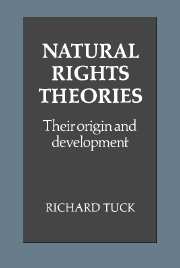1 - The First Rights Theory
Published online by Cambridge University Press: 05 June 2012
Summary
In 1515 a Dominican theologian, Silvestro Mazzolini da Prierio, summarised a debate which had been conducted over the previous two hundred years about the relationship between the concepts of dominium and ius, two words usually translated as ‘property’ and ‘right’, though to do so may sometimes obscure the history we need to clarify.
Dominium, according to some people, is the same thing as ius. So that anyone who has a ius in something, has dominium over it; and anyone who has a ius to the use of something, has dominium in it, and vice versa … According to other people, it is not identical, for an inferior does not have dominium over a superior, but he may have a ius against him. Thus for example a son has a ius to be fed by his father, and the member of a congregation has a ius to receive the sacrament from a prelate, etc. So they say, to have dominium implies that one has a ius, but not vice versa; for in addition to a ius one must have superiority.
Important issues were at stake in this argument. The first and more innovatory group (to which Mazzolini himself belonged) thought that any ius has to be something the operation of which its possessor could control himself – it had to be dominium with its implications of control and mastery. It was not simply a claim on other people, the justice of which ought to be recognised by them.
- Type
- Chapter
- Information
- Natural Rights TheoriesTheir Origin and Development, pp. 5 - 31Publisher: Cambridge University PressPrint publication year: 1979
- 3
- Cited by



